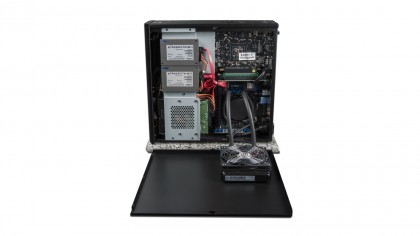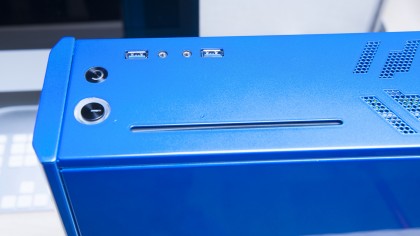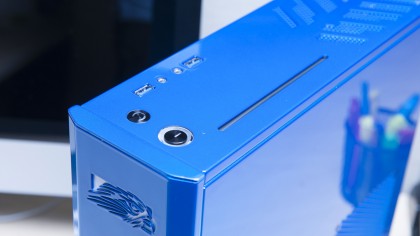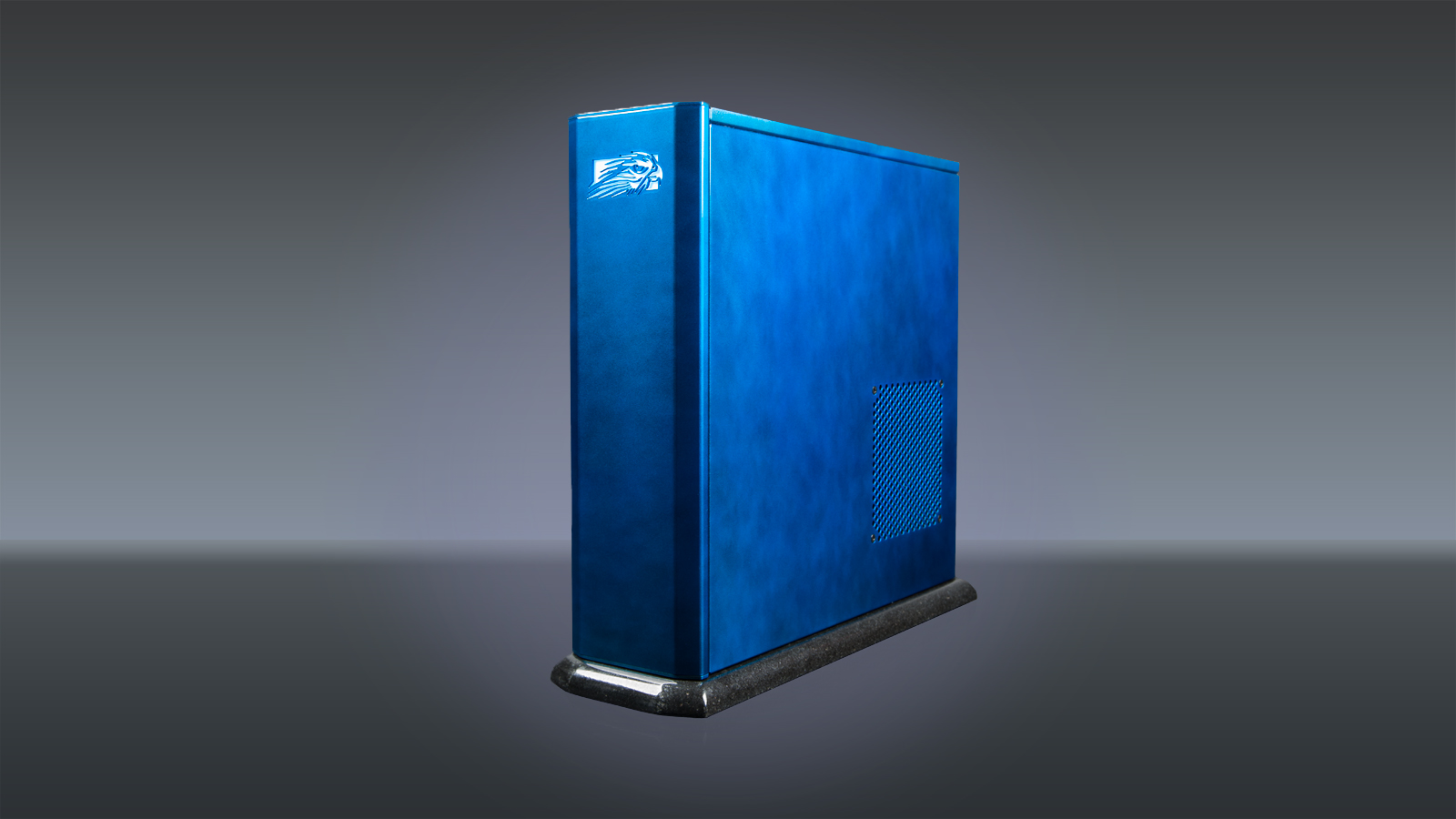Why you can trust TechRadar
Given Falcon's elite reputation, it's no surprise that the Tiki's innards are immaculate, with all cables neatly tucked out of sight, and plenty of open space to allow for more air circulation and more efficient cooling. This is an important consideration, given how quietly the system runs. (Four conveniently placed grills help greatly in this regard.)
For such a small box, the Tiki packs plenty of power. And as configured for TechRadar, this Tiki costs a cool $3,061 (about £1,819, AU$3,268). While this is no small amount of money, it does seem like a fair value given the top-shelf components detailed below.

Here is the Falcon Northwest Tiki configuration sent to TechRadar:
Spec sheet
- CPU: 3.5GHz Intel Core i7 4770K (quad-core, 8MB cache, up to 3.9GHz with Turbo Boost)
- Motherboard: Asus Z87i Deluxe
- Graphics: EVGA GeForce GTX 780Ti (3GB GDDR5 RAM)
- Cooling: Asetek 120MM liquid cooling loop
- Memory: 8GB DDR3 (1866MHz)
- Storage: Crucial 512GB M550 SSD; Western Digital Green 3TB, 7,200 rpm HDD
- Optical drive: Lite-On DVD-RW (8X, slim slot-loading)
- Operating System: Windows 8.1
- Power supply: 450W Silverstone ST-45B
- Ports: 2 USB 3.0, audio/mic jack (top); 6 USB 3.0, 4 USB 2.0, 2 DVI, 2 HDMI, 3.5mm audio/mic jack, SPIDF-out
As you've probably surmised, there is a lot to like here. The only real shock here is that all of the above manages to run on a 450W power supply.
Credit Falcon's decision to go with the Z87 chipset for that. For a fairly small form-factor rig, Z87 is a no-brainer, given Haswell's thermal efficiencies. The beauty of the Asus Z87i Deluxe in our test rig is that it is a no-compromise motherboard, providing an obscene number of USB 3.0 ports as well as some extra features like a BIOS flashback button. This allows PC nerds to flash the firmware using a USB thumb drive and dual-channel, 802.11ac Wi-Fi signal.
Like all Falcon NW systems, buyers can choose from a number of configuration options. For the motherboard, there's the option of either the default Asus Z87I deluxe or you can upgrade to the Asus Maximus VI Impact. (Both are Z87 chipset motherboards.)
CPU options scale from the default 3.2GHz Core i5 4570 to the 3.4GHz Core i5 4670K to the high-end 3.5GHz Core i7 4770K featured in TechRadar's test rig. The 4770K is a great choice for a high-end gaming PC for its unlocked multiplier, which allows for more extreme overclocking. You can, as expected, choose to have Falcon overclock your PC for no extra charge. (We did.)

Video card options are similarly robust, allowing for everything from the default 2GB GeForce GTX 750 Ti all the way up to workstation-caliber Nvidia Quadro cards – at 12GB, no less.
The system comes with either 8GB or 16GB of RAM, which may disappoint buyers looking for 32GB of memory. At default, the Tiki comes loaded with a Crucial M550 256GB M550 SSD and no mechanical drive. While you must choose solid state for the primary drive, the chassis can fit up to two additional drives for extra storage. SSD options range up to 1TB, and HDD options include Western Digital's 7,200 rpm, high-performance Green drives (between 2 and 4TB). You can even configure these drives in either RAID 0 and RAID 1.
If the relatively high-end price-tag makes your checking account feel bad, it is encouraging to know that at the low-end, you can get into a Tiki at $1,888 (about £1,122, AU$2019). That will net you an Intel Core i5 4570, the same Asus Z87i Deluxe mobo, 8GB RAM, 256GB SSD and a 2GB GeForce GTX 750 Ti video card.
Performance
Given the specifications above, it will probably come as no surprise to TechRadar readers that, in this configuration, the Tiki absolutely blew through our benchmark tests. Here are the results:
Benchmarks
- PCMark 8 Home: 4,876 ; Creative: 5,569
- Cinebench: 28,084 (7,231 with 1x CPU)
- 3DMark: Ice Storm: 147,696; Cloud Gate: 24,520; Fire Strike: 9,910; Fire Strike Extreme: 4,955
- BioShock Infinite: 120 fps
- Metro Last Light: 132 fps (medium quality)
The long and the short of the above numbers is that in all aspects of performance, the configuration specified above threw off favorable results. The Tiki deftly out-muscled CPU-intensive tasks like Cinebench and PCMark 8. This is certainly no surprise, given the overclocked Core i7 chip.
And, while I won't say I'm surprised by the Tiki's 3D performance – our Nvidia GeForce GTX 780Ti review left me fairly breathless – the sheer might of this rig was nevertheless impressive. One of my primary gaming systems is a massive, $5,000 full-size tower PC with a 4770K CPU, 32GB of RAM and a 6GB GeForce Titan card. To date, no system had bested it in neither synthetic nor gaming benchmarks. Across the board, the Tiki bested it by 8 to 10%.

What does all this mean in terms of real-world performance? The long and the short of it is that I was able to play any game I wanted on my ultra-wide 2560 x 1080 display at maximum detail levels, and was constantly rewarded with high, smooth frame rates.
Even more impressive is that, despite all this power, I had to try to produce any noticeable fan noise whatsoever. Even under peak performance loads, this is one seriously stealthy PC.
We liked
For starters, the Tiki packs an impressive amount of power and performance into a small, elegant-looking system. Its near-silent profile and relatively low power draw make it a fairly versatile system, equally capable of serving as a media center and gaming system in the living room or as a dedicated gaming PC.
Falcon offers a wide set of configuration options that allow for a nice (and not outrageously expensive) range of price versus performance – a major plus. Frankly, the choices are much broader than I would have expected, given the chassis' size.
At a higher level, the Falcon Northwest's willingness to experiment with a new form-factor is admirable. The custom chassis and the granite base are bold design touches, and fully embrace the notion that PCs can and should be exciting to look at. That this system is capable of out-gunning much bigger machines makes it all the more interesting.
We disliked
The only significant beef I have with the Tiki is that the custom chassis prevented me from laying the system on its side. This could make the PC tough to squeeze into a living room media center.
I fully admit that some people may find the granite base to be a bit much. I love it, though it does add a little too much weight to consider this a portable PC suitable for schlepping to LAN parties.
[Editors Note: We've been informed that users are able to remove the granite base through four screws underneath. This solution removes a considerable 6 pounds from the product's overall weight and makes portability easier. Also, Falcon Northwest informed us that it's capable of providing a Tiki with horizontal orientation, but not without special modifications to the chassis like rubber feet.]
One final nit to pick: Hardcore PC aficionados may be disappointed in the Asus Z87i motherboard's 16GB memory ceiling. Truthfully, most people don't need any more than this, unless they are running multiple virtual machines or working with humongous graphics and media files.
Final Verdict
No surprise here: Falcon Northwest's Tiki is a fantastic high-end system that quite elegantly sums up everything that is great about gaming PCs. It is extremely fast, tiny and looks gorgeous in almost any setting. Plus, even when fully loaded and running the latest games at maximum settings, this machine whispers. What more can you ask of a premium gaming machine?
